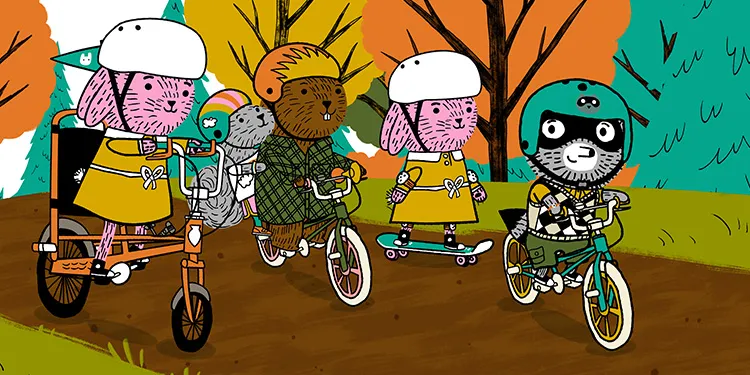November 13, 2024
Carl the Collector, right, with friends Nico and Arugula, identical twin bunny sisters with very different personalities; Sheldon, an empathetic beaver; and Lotta, a quiet and self-assured fox.
Carl the Collector, an animated series premiering on PBS KIDS on November 14, breaks ground as the first PBS KIDS show to feature central characters on the autism spectrum. The series follows the everyday adventures of Carl, a raccoon who enjoys collecting things and loves his friends and family in Fuzzytown. With his extraordinary attention to detail, Carl comes up with unique ideas that have helped him amass his extensive collections—from autographs and bottle caps to fake mustaches, pet rocks, sweaters, and virtually everything in between—which can come in handy for solving problems around the neighborhood with his friends.
[scald=849:sdl_editor_representation]
Carl the Collector | PBS KIDS #Shorts
Created by bestselling illustrator and author Zachariah OHora and produced by Fuzzytown Productions and Spiffy Pictures, with major funding from the Corporation for Public Broadcasting, the series is for children ages 4-8 and aims to celebrate the varied ways that kids think. CPB caught up with OHora to learn more about the production.

Zachariah OHora
Q: What inspired you to create “Carl the Collector”?
When my kids started going to school, they went to an inclusion school. Which meant every kid in the district got the same amount of teacher, classroom, and social time with whatever support they required to do that. As a result of that setting, I could see that my kids accepted everyone as they were. And I realized that if we have more exposure to the full spectrum of humanity at a young age, it will benefit everyone. Also, I have been obsessed with raccoons and collecting all my life.
Q: Why was it important to have a team of neurodiverse people working on this series? How did you build a team of neurodiverse writers, advisors, production staff, artists, and vocal talent?
A: The most important thing for me and for PBS, if we were going to explore this subject, is that it needed to be an authentic representation. Not try to tell someone’s story for them. So right from the start, we hired autism experts to learn from and guide every step of the show’s development. And just as importantly, we found neurodiverse people who could tell their own stories and experiences that would inform the show. When we got to casting, we knew we had to have autistic people voicing the characters onscreen, too. Director Lisa Whittick put out a casting call at a mom’s group she belongs to, for families with autistic children. That’s how we got Kai Barham and Maddy McIlwain (who voice Carl and Lotta) and other neurodiverse voice talent. I think that’s what comes through: These are real stories and lived experiences.
Q: What skills and values do you hope children and families will learn from watching “Carl the Collector”?
A: I hope that neurodiverse and neurotypical kids and their families see themselves in the show. I hope that it spreads empathy and understanding for the different struggles that people have. We don’t shy away from the tough parts, but we also celebrate all our differences. The show is also about managing your emotions and feelings, and there are moments that we demonstrate good techniques for doing that. You know, belly breaths and taking a moment and talking to someone who cares about you.
Q: What role has partnering with Maryland Public Television played in the production of “Carl the Collector”? What types of activities are they helping to create for station and parent engagement?
A; MPT has been an invaluable partner in creating videos and activities for teachers and parents that demonstrate all the ideas we are trying to get across in the show. They are also working on sensory friendly spaces and activities for station events, screenings, and guidelines for classrooms.
Q: What is most exciting about the interactive content being produced along with the new series, such as the games on PBSKIDS.org?
A: We have built some really fun games that I can’t wait to share. In the first game, kids get to play as Carl and explore Fuzzytown while they collect things and make their own collections. The developer has added features for neurodiverse players like control over sounds and brightness. Three other games and a host of online features all encourage more engagement with the show, help spread gratitude and kindness, and encourage the collector in all of us.
To subscribe to CPB spotlights, press releases and grant announcements, go to cpb.org/subscribe




